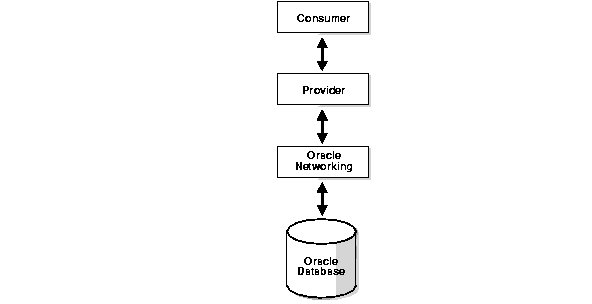Release 8.1.7
Part Number A85259-01
Library |
Product |
Contents |
Index |
| Oracle Provider for OLE DB User's Guide Release 8.1.7 Part Number A85259-01 |
|
This chapter introduces Oracle Provider for OLE DB (OraOLEDB). The following topics are discussed:
OraOLE DB is an open standard data access methodology which utilizes a set of COM interfaces for accessing and manipulating different types of data. These interfaces are available from various database providers.
Oracle Provider for OLE DB offers high performance and efficient access to Oracle data by OLE DB consumers.
OLE DB's design centers around the concept of a consumer and provider. Figure 1-1, "OLE DB Flow" is an illustration of the OLE DB system. The consumer represents the traditional client. The provider places data into a tabular format and returns it to the consumer.

OLE DB data providers are a set of COM components that transfer data from a data source to a consumer. The OLE DB Provider places that data in a tabular format in response to calls from a consumer. Providers can be simple or complex. A provider may return a table, it may allow the consumer to determine the format of that table, and it may perform operations on the data.
Each provider implements a standard set of COM interfaces to handle requests from the consumer. A provider may implement optional COM interfaces to provide additional functionality.
With the standard interfaces, any OLE DB consumer can access data from any provider. Because of COM components, consumers can access them in any programming language, such as C++, Visual Basic, and Java.
The OLE DB data consumer is any application or tool that utilizes OLE DB interfaces of a provider to access a broad range of data.
OraOLEDB now provides support for returning multiple rowsets. Consumers can use this feature to access all the REF CURSORs being returned by a stored procedure. See "Multiple Rowsets" .
OraOLEDB now provides support for the Unicode character set.
Using this feature, consumers can use OraOLEDB to access data in multiple languages on the same client machine. It can be especially useful in creating global Internet applications supporting as many languages as the Unicode standard entails. For example, one can write a single ASP page that accesses an Oracle8i database to dynamically generate content in Japanese, Arabic, English, and Thai. See "Unicode Support" and "Datatype Mappings in Rowsets and Parameters".
The following items are required on a system to use Oracle Provider for OLE DB:
www.microsoft.com/data/oledb
Review Oracle Provider for OLE DB release notes for detailed instructions on installing the OraOLEDB product.
During the installation process, the files listed in Table 1-1 are installed on the system.
Table 1-1 Oracle Provider for OLE DB Files
|
|
 Copyright © 1996-2000, Oracle Corporation. All Rights Reserved. |
|